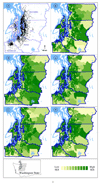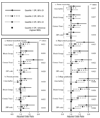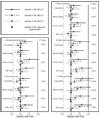Evaluating options for measurement of neighborhood socioeconomic context: evidence from a myocardial infarction case-control study
- PMID: 17950024
- PMCID: PMC2442019
- DOI: 10.1016/j.healthplace.2007.09.004
Evaluating options for measurement of neighborhood socioeconomic context: evidence from a myocardial infarction case-control study
Abstract
We hypothesized that neighborhood socioeconomic context would be most strongly associated with risk of myocardial infarction (MI) for smaller "neighborhood" definitions. We used data on 487 non-fatal, incident MI cases and 1873 controls from a case-control study in Washington State. Census data on income, home ownership, and education were used to estimate socioeconomic context across four neighborhood definitions: 1 km buffer, block group, census tract, and ZIP code. No neighborhood definition led to consistently stronger associations with MI. Although we confirmed the association between neighborhood socioeconomic measures and risk of MI, we did not find these associations sensitive to neighborhood definition.
Figures




References
-
- Adler NE, Ostrove JM. Socioeconomic status and health: what we know and what we don't. Ann N Y Acad Sci. 1999;896:3–15. - PubMed
-
- Berke EM, Gottlieb LM, Moudon AV, Larson EB. Protective association between neighborhood walkability and depression in older men. J Am Geriatr Soc. 2007;55:526–533. - PubMed
-
- Brameld KJ, Holman CD. The effect of locational disadvantage on hospital utilisation and outcomes in Western Australia. Health Place. 2005 - PubMed
-
- Braveman PA, Cubbin C, Egerter S, Chideya S, Marchi KS, Metzler M, Posner S. Socioeconomic status in health research: one size does not fit all. JAMA. 2005;294:2879–2888. - PubMed
-
- Carstairs V. Socio-economic factors at areal level and their relationship with health. In: Elliott P, Wakefield J, Best N, Briggs D, editors. Spatial Epidemiology: Methods and Applications. New York: Oxford University Press; 2000.
Publication types
MeSH terms
Grants and funding
LinkOut - more resources
Full Text Sources
Medical

